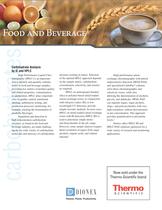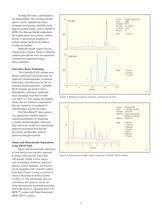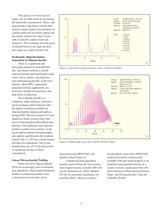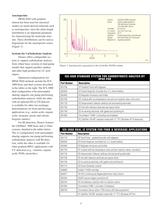 Website:
Thermo Fisher Scientific - Industrial & Applied S
Website:
Thermo Fisher Scientific - Industrial & Applied S
Group: Thermo Fisher Scientific
Catalog excerpts

Carbohydrate Analysis by IC and HPLC High Performance Liquid Chromatography (HPLC) is an important tool to identify and quantify carbohydrates in food and beverage samples, providing key metrics of product quality and related properties, contamination, or adulteration. HPLC plays important roles in quality control, nutritional labeling, authenticity testing, and production processes monitoring, for example, tracking the fermentation of alcoholic beverages. Separation and detection in high-concentration carbohydrate mixtures, as found in the food and beverage industry, are made challenging by the wide variety of carbohydrate molecules and intricacy of carbohydrate mixtures existing in nature. Selection of the optimal HPLC approach depends on the sample matrix, carbohydrate concentration, selectivity, and sensitivity required. HPLC on aminopropyl-bonded silica or polymer-based metal-loaded cation-exchange resins, in conjunction with refractive index (RI) or lowwavelength UV detection, provide simple isocratic methods. In most cases, HPLC on metal-loaded cation-exchange resins with RI detection (HPLC-RI) is used to determine simple monoand disaccharides in the g/L range. However, some sample matrices require better resolution of sugars from sugar alcohols, organic acids, and sodium chloride.1 Passion. Power. Productivity. High-performance anionexchange chromatography with pulsed amperometric detection (HPAE-PAD) and specialized CarboPac® columns solve these chromatographic and selectivity issues, while also allowing the determination of alcohols, glycols, and aldehydes. HPAE-PAD can separate sugars, sugar alcohols, oligo-, and polysaccharides with very high resolution, without derivatization or pre-concentration. This approach provides quantification to picomolar levels.2 Dionex offers HPLC-RI and HPLC-PAD solutions optimized for a wide variety of research and monitoring applications.
Open the catalog to page 1
HPLC-RI for Mono- and Disaccharides RI is the next most widely-used detection method for carbohydrates, as other alternatives such as fluorescence and UV-Vis detectors require pre-column derivatization of sugars. RI allows direct determination and quantification of sugars present in the percent range of most foods. Metal-loaded cation-exchange columns provide a simple, non-destructive method to separate carbohydrates using a deionized water mobile phase, which is compatible with RI detection. These columns separate compounds using a combination of size exclusion and ligand exchange...
Open the catalog to page 2
At high pH values, carbohydrates are deprotonated. The resulting anionic species can be separated by anionexchange mechanisms, typically using aqueous mobile phases such as NaOH or KOH. For oligosaccharide separations, the mobile phase also contains sodium acetate. Concentration gradients of sodium acetate facilitate the elution of oligosaccharides. High-pH eluents require the use of polymeric columns. Dionex CarboPac columns provide the basis for optimized carbohydrate separations using these conditions. Innovative Resin Technology The CarboPac PA20 column uses Dionex pellicular resin...
Open the catalog to page 3
The analysis of well-resolved sugars can be made faster by increasing the hydroxide concentration. Mono- and disaccharides important in dietary fiber analysis require higher concentrations of sodium hydroxide for timely elution and are readily eluted in less than 12 min with 52 mmol/L sodium hydroxide (Figure 5). This technique provides good resolution between the sugar alcohols and sugars in a single isocratic run. Predictable, High-Resolution Separation of Oligosaccharides There is a significant and increasing demand for reproducible, fast, and simple methods to profile oligosaccharides...
Open the catalog to page 4
Amylopectins HPAE-PAD with gradient elution has been used for structural studies on starch-derived materials such as amylopectins, since the chain length distribution is an important parameter for characterizing the molecular structure. These distributions can be used as fingerprints for the amylopectin source (Figure 7). Systems for Carbohydrate Analysis Dionex offers configurable systems to support carbohydrate analysis, from robust basic systems to dual-pump models that support parallel, tandem, and other high-productivity LC techniques. Optimized configurations for HPAE-PAD methods...
Open the catalog to page 5
References 1. De Vries, J. W.; Nelson, A. L., Food Technology 1994, July, pp. 76–77. UltiMate 3000 Standard System for Carbohydrate Analysis by HPLC-RI Part Number 2. Dionex Corporation. Technical Note 20: Analysis of Carbohydrates by High-Performance Anion-Exchange Chromatography with Pulsed Amperometric Detection (HPAE-PAD). 2004. SRD-3200 Solvent Rack with two degasser channels ISO-3100A isocratic analytical pump UltiMate 3000 Manual Injection Valve analytical/micro, with mounting kit and 20 μL sample loop TCC-3000 Thermostatted Column Compartment 3. Dionex Corporation. Technical Note...
Open the catalog to page 6All Thermo Fisher Scientific - Industrial & Applied S catalogs and technical brochures
-
Remel Spectra-VRE
2 Pages
-
Vanquish Duo UHPLC Systems
12 Pages
-
Vanquish UHPLC System
16 Pages
-
EASY-nLC 1200 System
8 Pages
-
Dionex Product Selection Guide
436 Pages
-
Dionex ICS-5000+ HPIC System
20 Pages
-
Dionex IC Solutions
8 Pages
-
Chemicals for a Global Market
16 Pages
-
Dionex Product Selection Guide
340 Pages
-
ICS-900 Brochure
4 Pages
-
ICS-2100/1600/1100
8 Pages
-
Combustion IC System
4 Pages
-
AutoTrace SPE Instrument
6 Pages
-
ICS-3000 System
16 Pages
-
Reagent-Free Ion Chromatography
12 Pages
-
Virtual Column
8 Pages
Archived catalogs
-
Surge Suppressor
19 Pages
-
Ion Chromatography
16 Pages















































